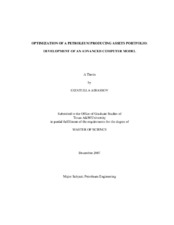| dc.description.abstract | Portfolios of contemporary integrated petroleum companies consist of a few dozen
Exploration and Production (E&P) projects that are usually spread all over the world.
Therefore, it is important not only to manage individual projects by themselves, but to also
take into account different interactions between projects in order to manage whole
portfolios. This study is the step-by-step representation of the method of optimizing
portfolios of risky petroleum E&P projects, an illustrated method based on Markowitz’s
Portfolio Theory. This method uses the covariance matrix between projects’ expected return
in order to optimize their portfolio.
The developed computer model consists of four major modules. The first module
generates petroleum price forecasts. In our implementation we used the price forecasting
method based on Sequential Gaussian Simulation. The second module, Monte Carlo,
simulates distribution of reserves and a set of expected production profiles. The third module
calculates expected after tax net cash flows and estimates performance indicators for each
realization, thus yielding distribution of return for each project. The fourth module estimates
covariance between return distributions of individual projects and compiles them into portfolios. Using results of the fourth module, analysts can make their portfolio selection
decisions.
Thus, an advanced computer model for optimization of the portfolio of petroleum
assets has been developed. The model is implemented in a MATLAB® computational
environment and allows optimization of the portfolio using three different return
measures (NPV, GRR, PI). The model has been successfully applied to the set of
synthesized projects yielding reasonable solutions in all three return planes. Analysis of
obtained solutions has shown that the given computer model is robust and flexible in
terms of input data and output results. Its modular architecture allows further inclusion
of complementary “blocks” that may solve optimization problems utilizing different
measures (than considered) of risk and return as well as different input data formats. | en |


